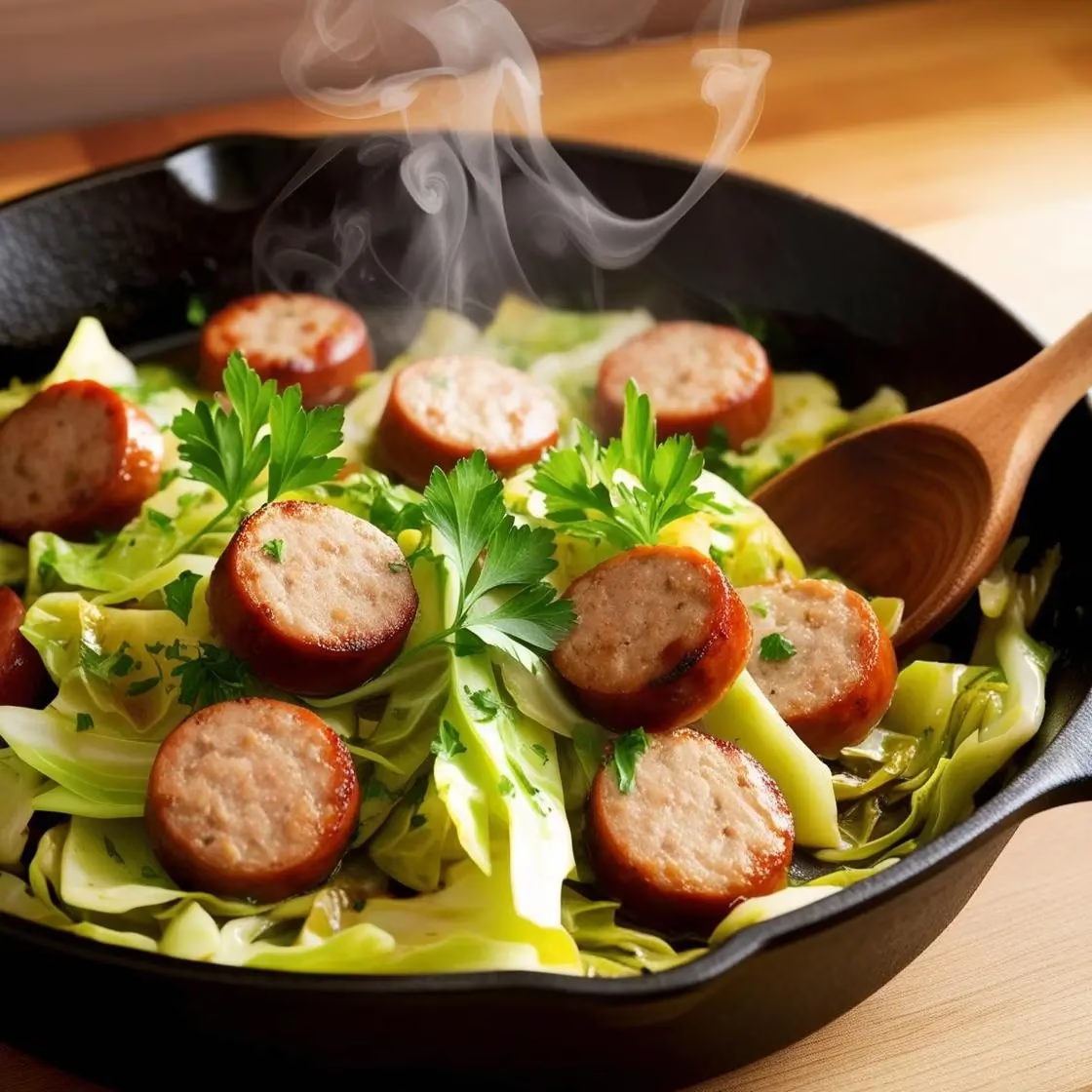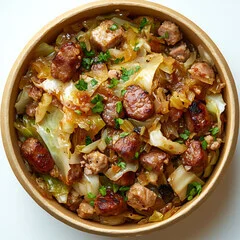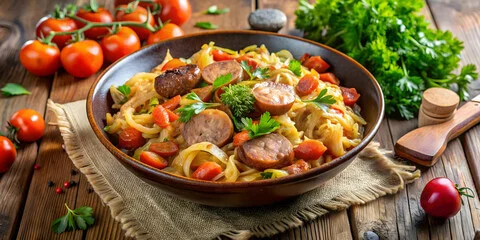Cabbage and sausage is a classic combination that has been a staple in many households for generations. This simple yet flavorful dish brings together hearty ingredients in a way that’s both comforting and satisfying. Whether you’re looking for a quick weeknight dinner or a delicious meal to serve to guests, cabbage and sausage hit all the right notes.
Table of content
- What Makes Cabbage and Sausage a Perfect Meal?
- Ingredients
- Step-by-Step Guide: Cooking Cabbage and Sausage (Instructions)
- Tips for Success
- Storing and Reheating
- FAQ
- Nutrition Information (approximate per serving)
- Other Recipes
What Makes Cabbage and Sausage a Perfect Meal?
The beauty of cabbage and sausage lies in its balance of flavors and textures. The savory, often smoky taste of the sausage pairs beautifully with the crisp and slightly sweet crunch of cabbage. It’s a dish that’s easy to make, nutritious, and filling, offering a comforting meal without requiring too many ingredients or complicated steps.

What sets cabbage and sausage apart is its ability to be both simple and hearty. This dish can be prepared with just a few basic ingredients like cabbage, sausage, garlic, and onions, making it perfect for busy evenings. The best part is that it’s incredibly versatile, meaning you can customize it with additional veggies, seasonings, or even potatoes for extra heartiness. Despite its simplicity, it’s a dish that feels like a true comfort food.
Cabbage and sausage is a dish that effortlessly combines simplicity, flavor, and versatility, making it a go-to recipe for many home cooks. Whether you’re preparing it for a weeknight dinner or a special family gathering, this recipe offers everything you need in a hearty, satisfying meal. Let’s dive into why this dish is so beloved and why you’ll love making it.
Ingredients
- 1 lb (450g) smoked sausage or kielbasa, sliced into rounds
- 1 medium head green cabbage (about 2 lbs/900g), cored and chopped
- 3 cloves garlic, minced
- 1 large onion, diced
- 2 tablespoons olive oil
- 1 teaspoon caraway seeds (optional)
- 1 teaspoon paprika
- ½ teaspoon red pepper flakes (adjust to taste)
- 2 tablespoons apple cider vinegar
- 1 cup chicken broth
- 2 tablespoons butter
- Salt and black pepper to taste
- Fresh parsley, chopped (for garnish)

Step-by-Step Guide: Cooking Cabbage and Sausage (Instructions)
- Prep Ingredients: Core and chop the cabbage into roughly 1-inch pieces. Dice the onion and mince the garlic. Slice the sausage into ½-inch rounds.
- Brown the Sausage: Heat 1 tablespoon olive oil in a large skillet over medium-high heat. Add the sliced sausage and cook until browned on both sides, about 5 minutes. Transfer to a plate and set aside.
- Cook Aromatics: In the same skillet, add the remaining tablespoon of olive oil. Add the diced onion and cook until softened, about 3-4 minutes. Add the minced garlic, caraway seeds (if using), paprika, and red pepper flakes, and cook for another 30 seconds until fragrant.
- Cook Cabbage: Add the chopped cabbage to the skillet. Stir to coat with the oil and spices. Pour in the chicken broth and apple cider vinegar. Season with salt and pepper. Cover and cook for 10 minutes, stirring occasionally.
- Combine: Return the browned sausage to the skillet. Continue cooking uncovered for another 5-7 minutes, or until the cabbage is tender and most of the liquid has evaporated.
- Finish: Stir in the butter until melted. Taste and adjust seasoning if needed.
- Serve: Garnish with fresh chopped parsley and serve hot.

Tips for Success
- Cabbage Prep: Don’t cut the cabbage too small as it will shrink during cooking. Aim for roughly 1-inch pieces.
- Sausage Selection: Fully cooked sausages work best for this recipe. Smoked varieties add excellent flavor.
- Even Browning: Don’t overcrowd the pan when browning the sausage to ensure it gets a nice caramelized exterior.
- Deglazing: After cooking the sausage, don’t discard those flavorful brown bits in the pan. The vinegar and broth will help release them, adding depth to the final dish.
- Texture Balance: Cook the cabbage to your preferred tenderness. Some prefer it with a slight crunch, while others enjoy it fully softened.
- Layer Flavors: Taste as you go and adjust seasonings accordingly. The dish should have a balance of savory, slightly acidic, and subtly sweet notes.
Storing and Reheating
- Refrigeration: Store leftovers in an airtight container in the refrigerator for up to 4 days.
- Freezing: This dish freezes well for up to 3 months. Cool completely before transferring to freezer-safe containers.
- Reheating: For best results, reheat in a skillet over medium heat with a splash of broth to maintain moisture. Microwave reheating works too, but cover the dish to prevent splatter and stir halfway through.
- Meal Prep: This recipe is excellent for meal prep as the flavors actually improve after a day in the refrigerator.

FAQ
Can I use a different type of cabbage?
Yes! Red cabbage works well but will give the dish a purple hue. Savoy cabbage or Napa cabbage are excellent alternatives with a slightly milder flavor.
Is this recipe keto-friendly?
Yes, this dish is naturally low in carbohydrates and suitable for keto diets. Just ensure your sausage doesn’t contain fillers with added sugars.
What can I add to make this a complete one-pot meal?
Try adding pre-cooked diced potatoes during the last 5 minutes of cooking, or stir in some white beans for added protein and fiber.
How can I reduce the fat content?
Use turkey or chicken sausage, and reduce the amount of butter or substitute with olive oil.
Nutrition Information (approximate per serving)
- Servings: 4
- Calories: 410 kcal
- Protein: 18g
- Carbohydrates: 15g
- Fat: 32g
- Fiber: 5g

Other Recipes
- Baked Chicken Breast With Honey Garlic Sauce
- Crusty Italian Bread
- Corn Dip
- Avocado halves stuffed with shrimp salad
- Beef and Noodles
- Beef Pot Pie
This Cabbage and Sausage Skillet is a testament to how simple ingredients can create something truly delicious. The combination of savory sausage and tender cabbage creates a comforting dish that’s both satisfying and economical. Perfect for busy weeknights or Sunday meal prep, this versatile recipe can be adapted to suit your taste preferences and what you have on hand. Enjoy this rustic, hearty meal that brings together old-world flavors in a modern, convenient preparation.

« How to Make the Best Cabbage and Sausage Recipe: A Simple, Flavorful Meal »
Description
A hearty, flavorful one-pan dish featuring tender cabbage and savory sausage. This comforting meal is quick to prepare, budget-friendly, and full of delicious flavor.
Ingredients
Instructions
- Prep Ingredients: Core and chop the cabbage into roughly 1-inch pieces. Dice the onion and mince the garlic. Slice the sausage into ½-inch rounds.
- Brown the Sausage: Heat 1 tablespoon olive oil in a large skillet over medium-high heat. Add the sliced sausage and cook until browned on both sides, about 5 minutes. Transfer to a plate and set aside.
- Cook Aromatics: In the same skillet, add the remaining tablespoon of olive oil. Add the diced onion and cook until softened, about 3-4 minutes. Add the minced garlic, caraway seeds (if using), paprika, and red pepper flakes, and cook for another 30 seconds until fragrant.
- Cook Cabbage: Add the chopped cabbage to the skillet. Stir to coat with the oil and spices. Pour in the chicken broth and apple cider vinegar. Season with salt and pepper. Cover and cook for 10 minutes, stirring occasionally.
- Combine: Return the browned sausage to the skillet. Continue cooking uncovered for another 5-7 minutes, or until the cabbage is tender and most of the liquid has evaporated.
- Finish: Stir in the butter until melted. Taste and adjust seasoning if needed.
- Serve: Garnish with fresh chopped parsley and serve hot.
Notes
- A suggestion to add beer for depth of flavor
Guidance on adding more broth if the dish becomes dry
A tip to include shredded carrots for color and nutrition
A variation using sauerkraut for tanginess

